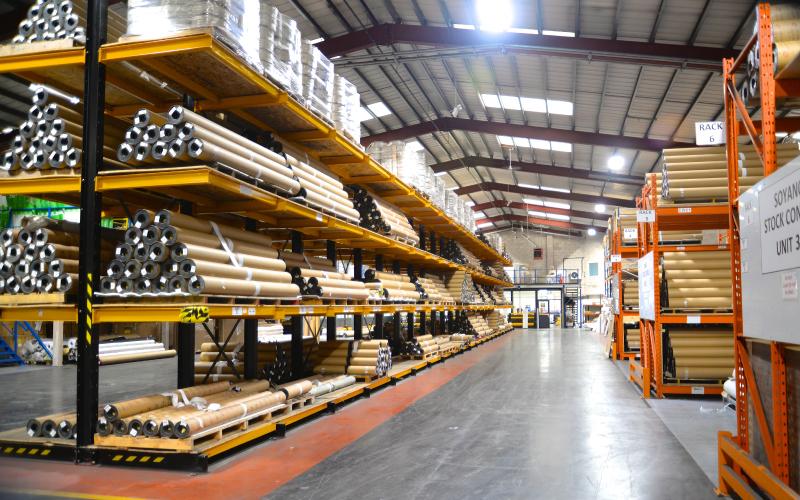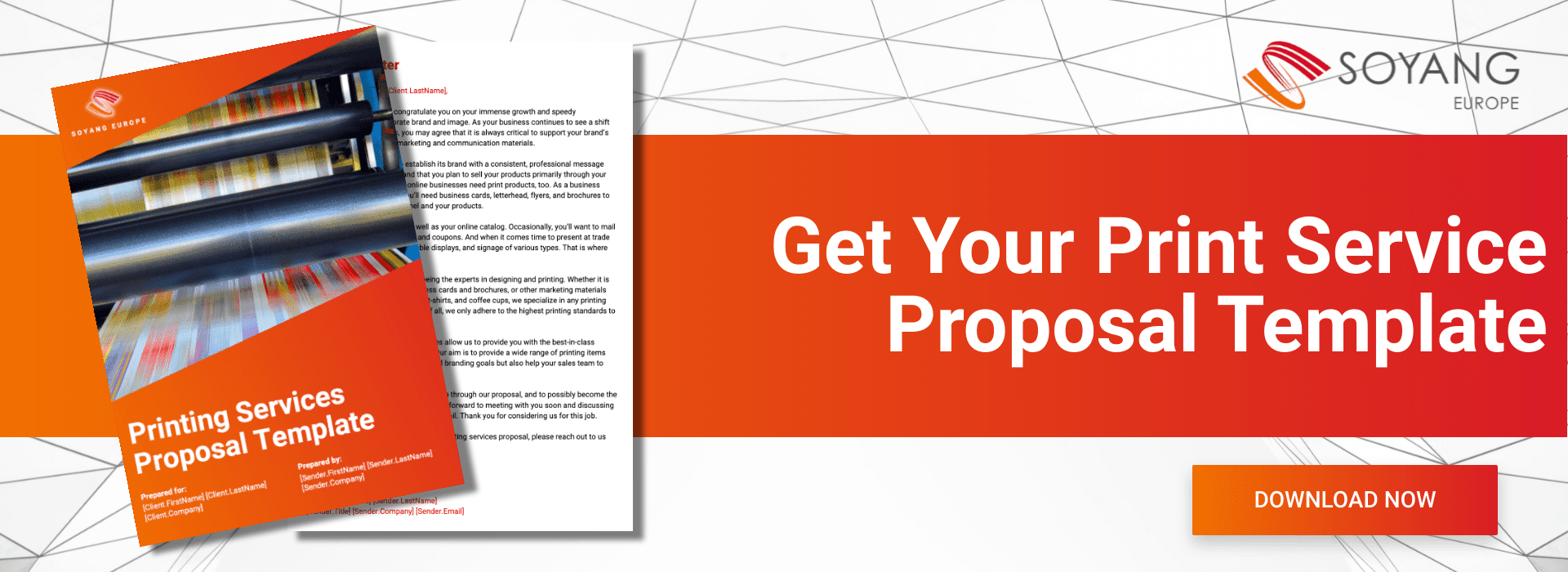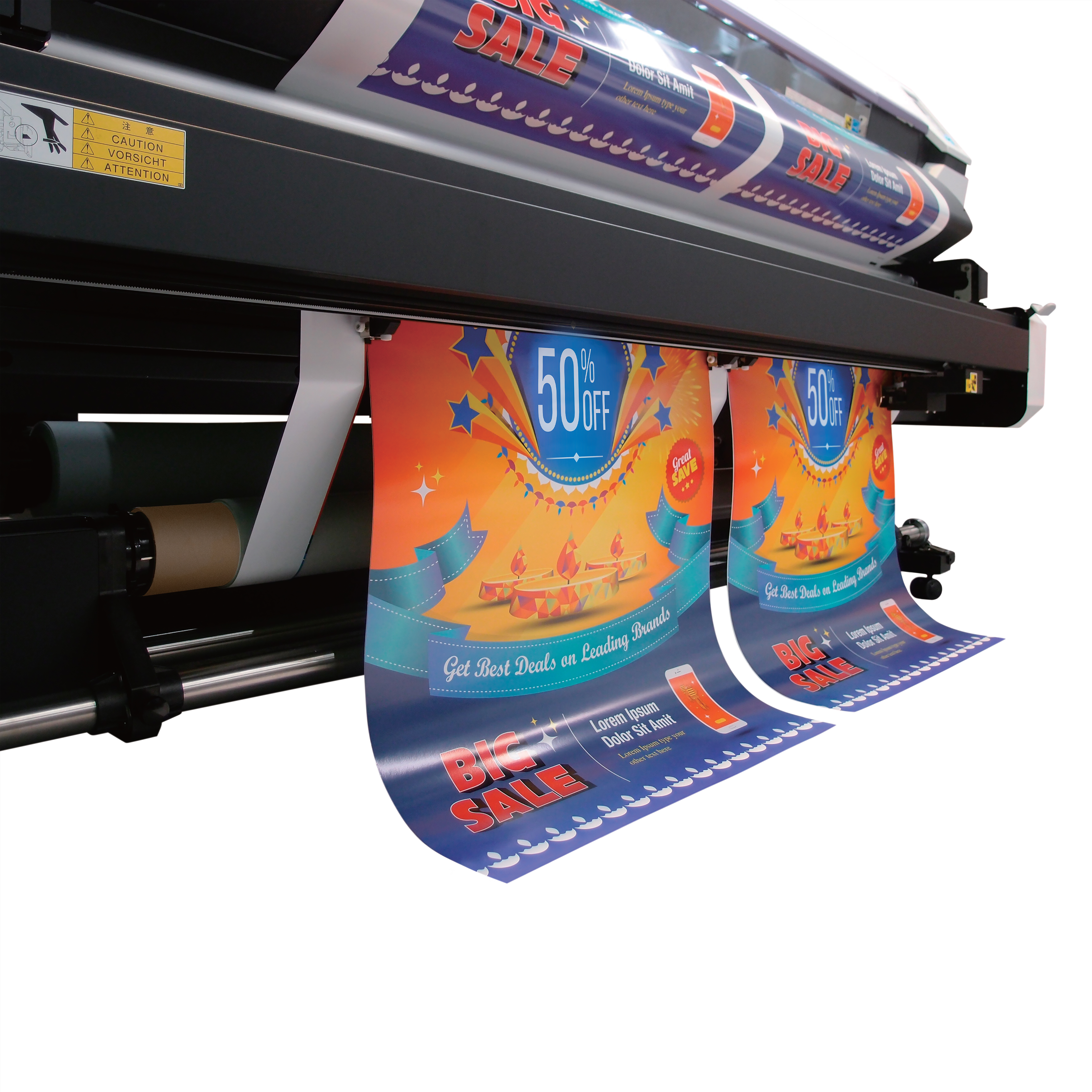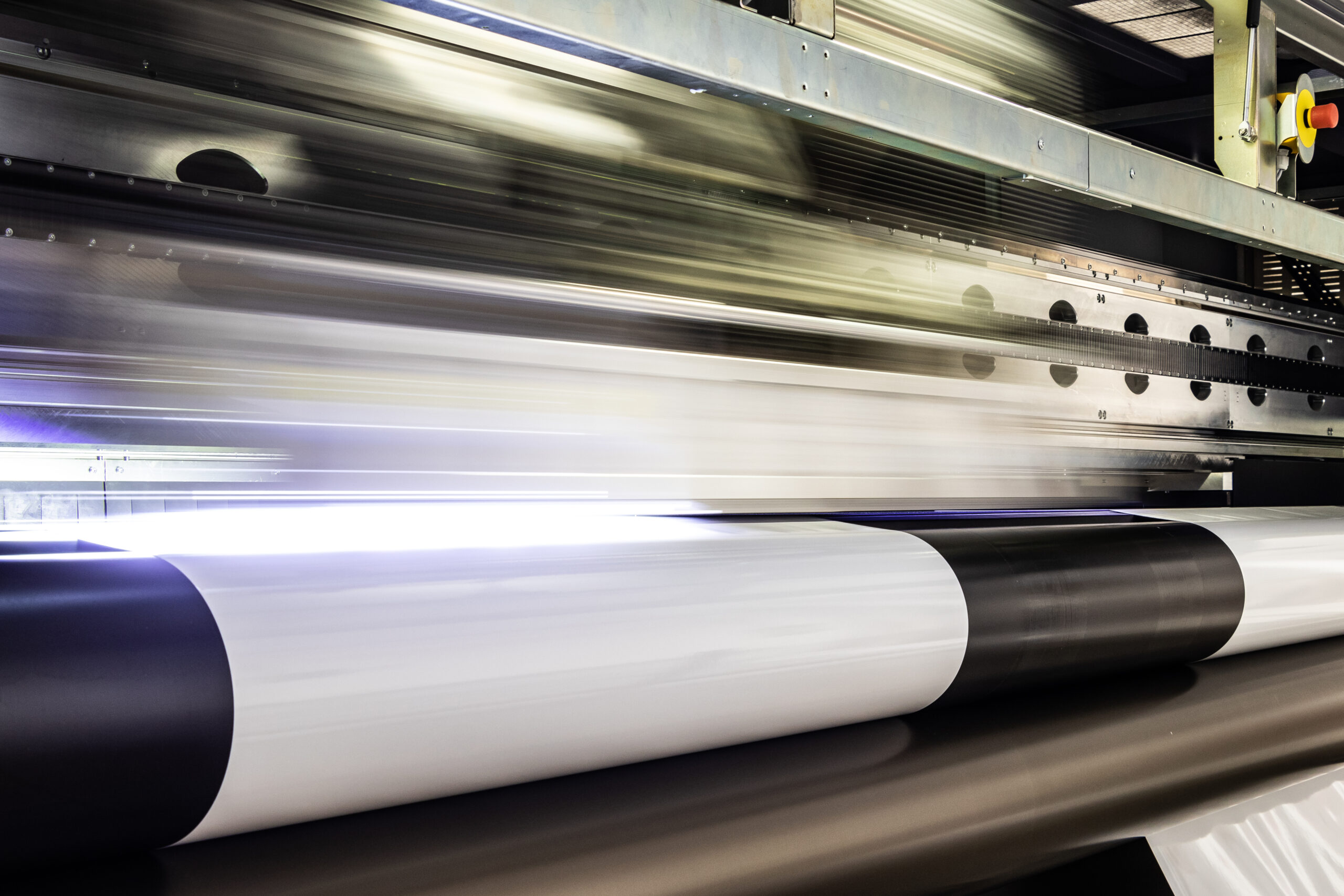The right products in the right place at the right time: that’s the aim of every inventory management system. But what benefit does printing inventory management offer and how, in a practical sense, should you put it to work in your print business?
In this Soyang guide, we’ll explain.
1. What is print inventory management?
(And while we’re at it, what is ‘inventory’?)
Let’s start right at the beginning. Inventory, in print shop terms, is stock. It’s all the materials that come into your business that you then turn into printed products and sell at a profit.
The paper, vinyl, canvas, ink, laminate and more that’s filling your stockroom shelves right now? It’s all inventory.
Inventory management is about keeping a tight control of your stock so you always have the right products in the right place at the right time.
2. Why does printing inventory management matter?
If your business buys and sells (as any print business does), inventory management will be a crucial part of ensuring it stays profitable.
Pull the purse strings of your print business too tight and order too little inventory, and you risk not having the right materials on the shelves when you need them. When a customer orders that new blockout banner, for example, if you don’t have the material at the ready, you risk the customer going elsewhere.
Order too much inventory though, and while you may have the print material ready to go the moment the order arrives, you risk damaging your cashflow, because so much of it is tied up in the stock on your shelves. The more you store, the more racking you need (which may in turn mean you need larger premises). The greater the risk it will get damaged. The longer you spend searching for the item you need among all your other inventory.
Too much inventory can be as problematic and costly as too little. Printing inventory management, then, is the Goldilocks of the print industry. It’s always in search of a balance that’s not too much and not too little, but just right.
3. Benefits of printing inventory management
Inventory management is all about giving you the ability to effectively control your business costs and maximise profit. It helps you make the right decisions.
You can summarise its benefits as visibility, control and costs.
3.1 Visibility
Inventory management puts systems in place that ensure you know what’s coming in and out of the business. Knowing where everything is can help reduce production hold-ups as you search for materials you know you have in stock but can’t find, or which you thought you had in stock but don’t.
Inventory visibility is the first step in ensuring you can make your commitments and deliver to deadline.
As we’ll see in a moment, one of the big reasons to invest in inventory management software is that it gives you a clear, simple view of your inventory.
3.2 Control
When you know what you’re working with – and what’s likely to come in and out of the business – you control your business rather than the other way round. Print inventory management helps ensure you’re in the driving seat of your business.
3.3 Costs
With a real focus on print inventory management, you can make your operation much more streamlined. Inventory management software can typically help you trim 10%-25% from your inventory while remaining able to meet the demands of your customers.
Imagine being able to drop the amount of stock you hold by 25%. Aside from the obvious cost saving of not having to buy the inventory in the first place, consider the additional benefits of being able to free up space. There’s the time saved in searching a stockroom that’s 25% less cluttered. And then there’s the risk prevention aspect – because when you carry 25% less stock, there’s 25% less to lose or damage.
4. What do print inventory management systems do?
As we’ll discover, not every aspect of inventory management needs to be (or can be) automated. But a significant part of it can.
An inventory management software system can crunch the data to give you the accurate information you need and present it in a way that gives you the visibility to forecast effectively. It can help you replenish in a timely way. It can help you keep track of your print materials suppliers and understand who’s supporting your supply chain in a positive way, and who’s a drain.
You’ll find more about some of the individual capabilities of a print inventory management system below.
5. Print inventory management best practices
Simple steps to gain control of your inventory and lower your operating costs.
5.1 Accurate demand forecasting
Some things you just can’t predict. The print product that goes viral? The client who gets a vast one-off order out of the blue? Those will always come from leftfield.
But there’s much you can predict about every year. Even now, without any data to back it up, you’ll know with a good degree of certainty when your peak season(s) will start and end. You’ll know when demand for a specific print product will grow and ebb, because it happens every year. You may even know the effect a planned marketing campaign tends to have.
Accurate demand forecasting, part of any respectable printing inventory management software system, uses historical data to help refine the accuracy of your forecasting, because the better you are able to forecast, the better you are able to maintain a lean approach to inventory management.
5.2 Smarter stock control
FIFO: First in, first out is an important rule of thumb for printing inventory management. A FIFO policy means that, when your stock order arrives, you place it on the shelf beneath or behind older stock. As a result, your oldest stock is continually rotated towards the front of the shelf, where it will be used next. FIFO helps avoid, for example, the situation where you have to discard old, unused ink or toner at the back of the store cupboard because it expired before you remembered it was there.
Categorisation: Not all inventory is the same. Some forms a vital part of your core work volume. Some is an essential driver of profit. And some is more niche. If you have lots of items in your print inventory management system, categorising them can be a valuable way of ensuring that you never lose sight of the inventory that really matters.
By prioritising, you ensure that, when resource or cashflow is tight, you always have the ‘bread and butter’ inventory you need to satisfy your most regular and/or profitable jobs/customers.
Inevitably, categorisation is a lot easier with the right software to help crunch the numbers.
Audit: A regular physical inventory audit will always be essential to ensure that what your system is telling you is correct. It can also help to identify issues with your system accuracy, staff training needs regarding your inventory processes, and even highlight a problem with theft.
Product specific reordering: “So what are we running low on?” For years, that’s been the standard approach to reordering, but it’s a generalised approach that treats every item of inventory the same.
For some inventory items, the point at which you’re running low may be too late.
Some products may have lengthy lead times, meaning that reordering needs to happen far sooner for those products than others. You may advertise a same/next day service with some print products (which means you’ll always need that inventory in stock), whereas other items may operate to a rather more relaxed timescale which makes constant replenishment less essential.
By establishing product-specific reordering triggers as part of your software system, you reorder based on the criteria you set for that particular item of stock.
5.3 Centralise your inventory system
If you operate from a single print shop, you already operate centralised print inventory management. But what if you operate a chain of print stores?
A decentralised print inventory management system means that each store operates its own inventory system, ordering according to its own requirements. That will ensure each individual print shop will always have the inventory it needs, but it could be an inefficient way of operating.
Suppose, for example, print shop A has a client who orders lots of printable vinyl flooring. Print shops B & C, which are part of the same organisation, have some vinyl flooring in stock but are rarely asked for it.
With a decentralised system, print shop A keeps ordering its stock, oblivious to the fact that there’s stock available in stores B & C. Print shops B and C keep their vinyl flooring in stock, unaware print shop A could use it, until one day a spillage damages store C’s flooring stock.
With a centralised system, you get a clear real-time view of inventory across your organisation. That enables you to shift surplus stock between units so no store ever ‘sits’ on inventory others could use. It also enables you to streamline buying, removing imbalance from across your organisation.
5.4 Adopt Just-in-Time (JIT) print inventory management
As the name suggests, Just-in-Time processes ensure that you’ve always got the stock you need, when you need it, without having to keep lots of inventory sat on store room racks.
JIT is certainly not confined to the print sector. It’s used throughout industry, but it always requires the same core ingredients to work effectively:
Customer understanding: If you want to supply your customers with print materials just as they need them, you’ll need to have a clear understanding of how their needs change throughout the year. Accurate demand forecasting (see 5.1) is, therefore, a key factor in JIT.
Inventory understanding: This is about understanding the way stock travels through your business. What stock heads back out the door almost as soon as it arrives? What stock ‘sticks’? The right inventory management system can help you understand your stock situation in detail.
Supplier understanding: You can have all the data in the world that enables you to understand your customers and the materials they buy, but the third element of JIT is about relationships as much as data.
That’s because, if you’re to be able to operate a JIT form of printing inventory management, you need your suppliers to be able to feed you with the materials you need, as you need them. That means they have to understand your goals and ambitions, and you have to understand the constraints they work under and, if necessary, find a way around any obstacles so they can support you in your JIT drive.
5.5 Improve your supplier relationship management
It’s easy to say that it’s important to cultivate strong supplier relationships, but the fact that so many vendor collaborations crumble is all the evidence you need to know that organisations need to be better at – or simply invest more in – their supplier relationships.
As we’ve already seen, supplier relationships are a central pillar of a JIT print inventory management strategy, but they are also important in agreeing preferential terms, in encouraging a supplier to go the extra mile with a rush job, and extending your credit should you need it.
Three core ingredients of supplier/vendor relationship management are:
Make them part of the team: There’s more to making a supplier feel a valuable part of your organisation than simply saying it. They have to feel it and see it in action. Share your objectives with them. Develop combined goals, because a client win for you is inevitably going to be a win for them. Involve them in making plans for specific projects. Let them be part of setting timescales. It all helps to build trust between you and shift the relationship from purely transactional to one of genuine partnership.
Communicate: Your suppliers won’t know what’s coming up unless you tell them. They won’t know that priorities have changed unless you alert them. They won’t be able to act on your clients’ feedback unless you share it with them. Any relationship thrives on communication, so make sure it’s front and centre of yours.
Focus on the long term: It’s not really a relationship if it’s entirely one sided. Nor is it a relationship if it only lasts five minutes. So rather than trying to pin your suppliers down to the lowest possible cost, think of the value of the relationship over the longer term.
Consider the trust you can build and the effect that can have on the ease and speed of preparing quotes, the shared projects from which you can both benefit, and the way each can occasionally help the other out of a hole.
Over the long term, such factors can be worth far more than nibbling a few pence off a price.
5.6 Carry buffer stock
A true JIT system shouldn’t need buffer stock – that’s effectively the opposite of JIT. But the reality of printing inventory management is that not every item or supplier may be able to work within a JIT model. Depending on your categorisation (see above), you may not want to operate JIT with inventory that’s in greatest demand.
For those essential products that don’t fit a JIT model, or for business-critical inventory where you’re prepared to work with a higher level of stock to ensure you meet client expectations, set an acceptable level of buffer stock and keep to it.
5.7 Analyse & optimise
This may not feel like the most important element of best practice in setting up your print inventory management system, but in many ways it’s the one that unlocks everything else.
If inventory management is about control and knowing when to pull certain stock levers, it’s the ability to analyse data that gives you the information on which to base those lever-pulls.
Using your inventory management system, analyse your inventory data against your KPIs like stock levels, carry costs, fill rates, and stock turnover. Identify the issues, then develop strategies to resolve those issues, optimise inventory levels and stay in control of costs.
5.8 Bring your people with you
We’ve explored the fundamentals of effective print inventory control, but one element we’ve not yet discussed is the one element that can arguably have a greater influence on your inventory management than any other: your people.
It’s not enough to install systems and processes without explaining to your people why those measures are important. Nor is it enough to implement them without training your people to operate them.
After all, it’s your people who will be running (or adding data to) your management system and complying with your procedures. It’s your people who will be storing and rotating your inventory in a way the protects it and your investment. And it’s your people who will have the experience and insight to suggest other efficiencies you could explore.
The better the training you give them, the more you explain your reasoning, and the more regularly you share the positive results with them, the more they’ll help make your printing inventory management a success.
Talk to Soyang
So much of getting the print inventory right is about working with the right materials and the right supply partner. To explore how Soyang could help you achieve your business goals, talk to us.










